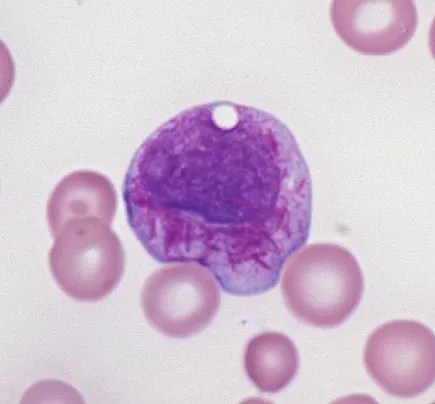Subacute granulomatous thyroiditis
“Thyroiditis” means “inflammation of the thyroid gland” (any time you see “-itis,” think “inflammation”). (more…)
“Thyroiditis” means “inflammation of the thyroid gland” (any time you see “-itis,” think “inflammation”). (more…)
The term “left shift” means that a particular population of cells is “shifted” towards more immature precursors (meaning that there are more immature precursors present than you would normally see). (more…)
Sickle cell anemia is one of a larger group of inherited red blood cell disorders called hemoglobinopathies. (more…)

Factor V Leiden is a genetic disorder in which patients have an increased tendency to form thromboses, or blood clots. (more…)
Papillary thyroid carcinoma has a number of unique morphologic features. I mentioned psammoma bodies a few days ago. (more…)
Just as there are many different types of myeloid cells (neutrophils, red cells, monocytes, eosinophils, basophils), there are many different types of acute myeloid leukemia (AML). Two types of AML are composed almost entirely of cells of the monocytic series: acute monoblastic leukemia and acute monocytic leukemia. In both of these types of AML, at least 80% of the leukemic cells are from the monocytic series (monoblasts, promonocytes, and monocytes). In acute monoblastic leukemia, most of these cells are monoblasts, and in acute monocytic leukemia, most of these cells are promonocytes. Promonocytes have a very characteristic appearance, as shown above. They have nuclei that show a delicate folding pattern, almost like a piece of tissue paper that has been crumpled a bit. If you had a case of acute leukemia and most of the cells looked like this, you would think about acute monocytic leukemia – and you’d get an NSE to prove it.

Some cases of acute leukemia are composed entirely of undifferentiated-appearing blasts. These cases are difficult (or impossible) to diagnose morphologically (under the microscope) – you really need special tests like immunophenotyping in order to make a definitive diagnosis. (more…)
Polycythemia vera (PV) is a chronic myeloproliferative disorder in which the red cells are the predominant lineage. Here are some typical student questions along with my answers. (more…)
Studying hematopathology can be a challenge. There are so many new words and concepts that it can seem overwhelming at times. (more…)
Recent Comments